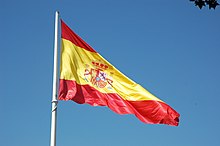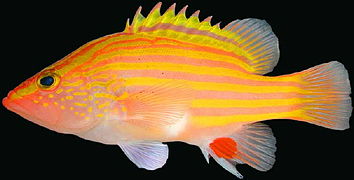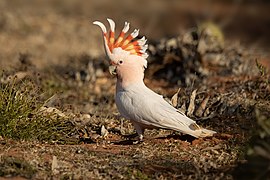Spanish flag
The flag of Spain, known as la rojigualda, was adopted as the national flag of Spain in 1785 and has been the national flag ever since, except for the years of the Second Republic (1931-1939), when it was replaced by another banner. The shield, which is included in the current flag, in some cases regulated by Law 39/1981, which regulates its use, has undergone several modifications throughout history.
The 1978 Constitution specified in its article 4.1:
The flag of Spain is made up of three horizontal, red, yellow and red stripes, being the yellow of double width that each of the red ones.Article 4.1 of the Spanish Constitution.
Shield and colors
Shield
On October 28, 1981, Law 39/1981 on the use of the Spanish flag and other flags and banners, says in its article 2.2: "In the yellow strip it will be possible to incorporate, in the form that is indicated by regulation, the coat of arms of Spain".
It must be taken into account that there is no constitutional shield, but a constitutional flag, which is the flag without a shield, since the Shield of Spain does not appear in the Constitution, but in a subsequent law.
The shield of Spain is regulated by Law 33/1981, of October 5, and by Royal Decree 2964/1981, of December 18, which also specifies the position of the shield on the flag.
According to the aforementioned regulations, the flag of Spain will have the following characteristics:
- The flag is made up of three horizontal, red, yellow and red stripes, being the yellow of double width than each of the red ones. This provision is known as a Spanish strip.
- The flag may incorporate the Spanish shield, but its incorporation is only mandatory in the cases provided for by regulation.
- The shield will have a height of two fifths of the width of the flag and will appear on both sides of it in the center of the yellow strip.
- When the flag has the normal ratio, in length equal to 3/2 of the width, the axis of the shield will be placed at a distance from the vain of the middle width of the flag. If the length is less than normal or the flag has a square shape, the shield will be placed in the center of the flag.
Colors
The colors of the Spanish flag, as specified in Royal Decree 441/1981, of February 27, which technically specifies the colors of the Spanish Flag, in accordance with the reports prepared by the Military Standardization Service, in collaboration with the Institute for Rationalization and Standardization (IRANOR), are the following:
| Color | Denomination | CIELAB | CIE 1931 | ||||
|---|---|---|---|---|---|---|---|
| Tono H* | Croma C* | Clarity L* | And | X | and | ||
| Red | Red flag | 35o | 70 | 37 | 9,5 | 0.614 | 0.320 |
| Yellow | Yellow Gualda Flag | 85th | 95 | 80 | 56.7 | 0.486 | 0.469 |
The institutional image guide of the state establishes colors in RGB and four-color (CMYK) for graphic representations of the flag and its shield, although these colors are not official and it is only an institutional guide. The colors for the flag are:
| Color | RGB | Web colours | Cuatricromy (CMYK) | |||||
|---|---|---|---|---|---|---|---|---|
| R | G | B | HTML code | Cian | Magenta | Yellow | Black | |
| Red | 173 | 21 | 25 | #AD1519 | 0% | 88% | 86% | 32% |
| Yellow | 250 | 189 | 0 | #FABD00 | 0% | 24 per cent | 100% | 2% |
History
It is possible to consider that the vexilos (word origin of the term vexillology) used by the Roman legionnaires, during the rule of the Iberian Peninsula by Rome, were the first insignia employed in Roman Hispania. The Visigoths continued to use this type of rigid banner with some kind of cloth; but it was not until the Islamic invasion that what we now know as "flags" began to be used, since the use of light fabrics in the banners, such as silk, originated in the East, with the Muslims and the Crusaders being the first to introduce its use in Europe. The flags became scripts and representative banners of kings and lords (specifically, their lineages or royal houses), rather than territories or nations, as national ensigns are used today. The earliest currencies assimilable to original flags of a «national» character of Spain are the models that were used both as torrotitos, pavilions and flags of Earth in the XVI, after the marriage of Juana I of Castile (daughter of the Catholic Monarchs) with the Archduke of Austria Felipe «el Hermoso». A common element was then introduced in the Spanish flags of the time: the Burgundian cross, which, although suffering slight variations with each king (as in the case of Felipe II, who ordered that the white cloth where the cross was located be changed to the color yellow), became the vexilological symbol par excellence of Spain.
With the advent of the House of Bourbon with Felipe V, the previous design was replaced by another: the royal arms on white cloth. White (typical of the Bourbons) was also the cloth used in the XVIII century by the different Bourbon branches that reigned in France, Naples, Tuscany, Parma or Sicily, in addition to Spain, so Carlos III decided to change the national flag of Spain to better differentiate himself from those of these other nations.
This is how the current design of the national flag arose with the Royal Decree of May 28, 1785, by which Carlos III resolved to hold a contest called to adopt a new Navy flag, choosing two designs: one for warships and another for merchant ships, among the twelve proposals presented to him by Antonio Valdés and Fernández Bazán, at that time Secretary of State and of the Universal Navy Office (Minister of the Navy). In order to publicize the new ensign, a General Ordinance was promulgated, which in treaty IV, title I, provided:
To avoid the inconveniences and damages you have seen the experience can cause the National Flag that uses My Navy and other Spanish Boats, equating in long distances or with calm winds with that of other Nations, I have decided that henceforth use my Bandera warships divided along three lists, of which the crown high and the lower are incarnated and of the width each And that the other landings use, without Shield, the same colors, should be the list of yellow and the width of the third part of the flag, and each of the parts divided into two equal parts incarnated and yellow alternatively, all according to the attached design. It will not be possible to use other Pavellones in the North Seas for Europe to the parallel of Tenerife in the Ocean, and in the Mediterranean from the first year of a thousand seven hundred and eighty-six; in the North America from the beginning of July following; and in the other Seas from the first of the year thousand seven hundred and eighty-seven. You will have it understood for its fulfillment.S.M. hand signaling. In Aranjuez, twenty-eight May of seven hundred and eighty-five.
Use on land
In 1793 it was ordered that this flag, used until then only on warships with the shield reduced to two quarters, would also fly in the ports and forts of the Navy and coasts guarded by the Army. The rojigualda flag began to be used in army camps and border fortifications during the war against the Convention, although being an Army flag the coat of arms is represented in the Castilla y León barracks on the colors of the naval flag. From 1808 given the explosion of patriotic sentiment during the War of Independence, the red and gold colors were used by the people and for volunteer flags, and were made official as colors of the Cortes of Cádiz and the national militia.
Finally, in 1843, the decree of October 13 of the second government of Joaquín María López, exposed the need to suppress the differences between the national flag and the private flags of the Army corps, and ordered the unification of all the flags and banners for use in the Kingdom of Spain:
The banners and banners of all the bodies and institutes that make up the Army, the Navy and the National Militia, will use the same in colors to the Spanish war flag, and placed these in the same order that they are in it.
The First Spanish Republic, installed in 1873, did not change the colors of the flag, but all the royal symbols of the monarchy were suppressed from the shields.
Although the use of the rojigualda became general during the remainder of the century, it was not until 1908 (Royal decree providing that on the days of the National Holiday the Spanish flag be flown in all public buildings, extending hangings and illuminations, Gaceta de Madrid, number 26, of January 26), which made it mandatory for it to wave in all public buildings on national holidays. By Royal Decree of July 19, 1927, during the Primo de Rivera dictatorship, It was decided that the merchant navy would use the same flag as the war fleet but without a shield, and the civil flag with five stripes was abolished.
This rojigualda design is preserved to this day, although there have been constant variations of the coat of arms. Only the proclamation of the Second Republic in 1931, during which the tricolor flag with horizontal stripes of equal size between them was used, replacing red with purple in the lower strip, constituted a parenthesis in its use. After the Civil War, the two-color flag returned, but with the new shield model, the 1938 model (approved on February 11, 1938). Subsequently, the shield was changed on two more occasions, with the 1945 models (approved on October 11, 1945), and 1977 (approved on January 21, 1977), up to the current 1981 model.
Regarding the use of the flag, article 3 of Law 39/1981, of October 28, establishes:
The flag of Spain will have to wave abroad and occupy the preferred place within all the buildings and establishments of the central, institutional, autonomous, provincial or island and municipal government.
For its part, the judgment of the Supreme Court of July 24, 2007 clarifies:
The flag must wave on a daily basis, not of conjuncture, not of exceptionality but of generality and at all times.
Other current flags
Historical flags
Flag with the cross of Saint Andrew with the correct proportions. Burgundy Cross, introduced by the House of Austria. With different designs it was used as a naval and merchant teacher until the arrival of the House of Bourbon and, equally with different designs, as taught by the different regiments until 1843
In animals and plants
Due to the resemblance to the colors of the Spanish flag, there are animals and plants known by the name "Spanish flag":
- Lantana camara. Arbusto ornamental of great resistance, known as "Spanish flag", "Spanish flag" or "five blacks". Apart from reddish it also appears in the range of white to pink.
- Ipomoea versicolor. Native ornamental climber from Mexico. Most frequently known as "vid de fuego" (in English, fire I came).
- Gonioplectrus hispanus. Fish from the waters of the popular Caribbean in aquariumphilia.
- Lophochroa leadbeateri. The flagpole, Spanish flag cacatúa, or Leadbeater Cacatúa, is a kind of psittaciform bird of the endemic Cacatuidae family of Australia, being one of the most frequent cacatúas in the semi-arid regions of the country.
Contenido relacionado
Assault Guard
Alhambra
Roman monarchy








































